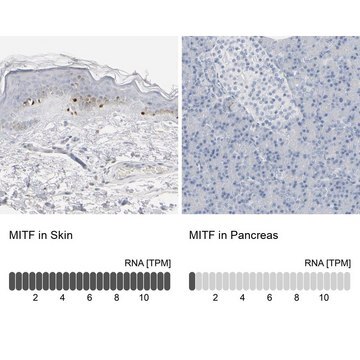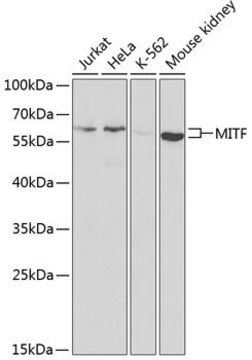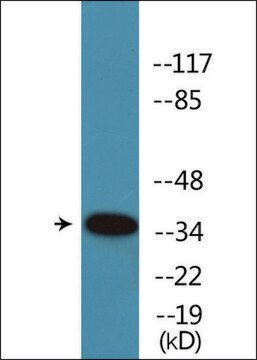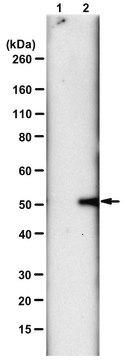Allgemeine Beschreibung
We are committed to bringing you greener alternative products, which adhere to one or more of The 12 Principles of Green Chemistry.This antibody is Preservative-free, produced without the harm or sacrifice of animals and exceptionally stable to allow for ambient shipping and storage if needed and thus aligns with "Waste Prevention", "Designing Safer Chemicals" and "Design for Energy Efficiency".
Click here for more information.
ZooMAb® antibodies represent an entirely new generation of recombinant monoclonal antibodies.Each ZooMAb® antibody is manufactured using our proprietary recombinant expression system, purified to homogeneity, and precisely dispensed to produce robust and highly reproducible lot-to-lot consistency. Only top-performing clones are released for use by researchers. Each antibody is validated for high specificity and affinity across multiple applications, including its most commonly used application. ZooMAb® antibodies are reliably available and ready to ship when you need them.
Spezifität
Clone 1E2 is a Rabbit recombinant monoclonal antibody that specifically detects Microphthalmia-associated transcription factor (MITF). It targets an epitope within 17 amino acids from the N-terminal half.
Immunogen
KLH-conjugated linear peptide corresponding to 17 amino acids from the N-terminal half of human Microphthalmia-associated transcription factor.
Anwendung
Quality Control Testing
Evaluated by Western Blotting in mouse kidney tissue lysate.
Western Blotting Analysis: A 1:1,000 dilution of this antibody detected MITF in mouse kidney tissue lysate.
Tested applications
Western Blotting Analysis: A 1:1,000 dilution from a representative lot detected MITF in human kidney tissue lysate.
Immunocytochemistry Analysis: A 1:100 dilution from a representative lot detected MITF in HeLa, A431, HUVEC, and NIH3T3 cells.
Affinity Binding Assay: A representative lot of this antibody bound MITF with a KD of 1.0 x 10-7 in an affinity binding assay.
Immunohistochemistry (Paraffin) Analysis: A 1:100 dilution from a representative lot detected MITF in human skin tissue sections.
Note: Actual optimal working dilutions must be determined by end user as specimens, and experimental conditions may vary with the end user
Anti-MITF, clone 1E2 ZooMAb®, Cat. No. ZRB1335, is a recombinant Rabbit monoclonal antibody that specifically targets MITF and is tested for use in Affinity Binding Assay, Immunocytochemistry, Immunohistochemistry, and Western Blotting.
Zielbeschreibung
Microphthalmia-associated transcription factor (UniProt: O75030; also known as Class E basic helix-loop-helix protein 32, bHLHe32, MITF) is encoded by the MITF (also known as BHLHE32) gene (Gene ID: 4286) in human. MITF is a transcription factor that regulates the expression of genes with essential roles in cell differentiation, proliferation, and survival. It is expressed in kidney and melanocytes. Isoforms C2, H1 and H2 are mainly expressed in kidney and isoforms M1 and Mdel are expressed in melanocytes. Isoforms A2 and C2 are detected in retinal pigment epithelium. It is present in homodimeric or heterodimeric form. Its dimerization is mediated via the coiled coil region (aa 355-402). Its efficient DNA binding requires dimerization with another bHLH protein. It binds to M-boxes (5′-TCATGTG-3′) and symmetrical DNA sequences (E-boxes) (5′-CACGTG-3′) found in the promoters of target genes, such as BCL2 and tyrosinase (TYR). MITF plays an important role in melanocyte development by regulating the expression of TYR and tyrosinase-related protein 1 (TYRP1). It also plays a critical role in the differentiation of various cell types, such as neural crest-derived melanocytes, mast cells, osteoclasts, and optic cup-derived retinal pigment epithelium. It can undergo phosphorylation at serine 405, which enhances its ability to bind the tyrosinase promoter. Its phosphorylation at serine 180 and serine 516 following KIT signaling, trigger a short-lived activation. These phosphorylations by MAPK and RPS6KA1, respectively, activate the transcription factor activity, but also promote ubiquitination and subsequent degradation by the proteasome. Mutations in MITF gene have been linked to cutaneous malignant melanoma and Waardenburg syndrome 2A, which is characterized by sensorineural deafness and pigmentary disturbances. This ZooMAb® recombinant monoclonal antibody, generated by our propriety technology, offers significantly enhanced specificity, affinity, reproducibility, and stability over conventional monoclonals.
Physikalische Form
Purified recombinant rabbit monoclonal antibody IgG, lyophilized in PBS with 5% Trehalose, normal appearance a coarse or translucent resin. The PBS/trehalose components in the ZooMAb® formulation can have the appearance of a semi-solid (bead like gel) after lyophilization. This is a normal phenomenon. Please follow the recommended reconstitution procedure in the data sheet to dissolve the semi-solid, bead-like, gel-appearing material. The resulting antibody solution is completely stable and functional as proven by full functional testing. Contains no biocide or preservatives, such as azide, or any animal by-products. Larger pack sizes provided as multiples of 25 μL.
Rekonstituierung
300 μg/mL after reconstitution at 25 μL per vial. Please refer to guidance on suggested starting dilutions and/or titers per application and sample type.
Lagerung und Haltbarkeit
Recommend storage of lyophilized product at 2-8°C; Before reconstitution, micro-centrifuge vials briefly to spin down material to bottom of the vial; Reconstitute each vial by adding 25 μL of filtered lab grade water or PBS; Reconstituted antibodies can be stored at 2-8°C, or -20°C for long term storage. Avoid repeated freeze-thaws.
Rechtliche Hinweise
ZooMAb is a registered trademark of Merck KGaA, Darmstadt, Germany
Haftungsausschluss
Unless otherwise stated in our catalog or other company documentation accompanying the product(s), our products are intended for research use only and are not to be used for any other purpose, which includes but is not limited to, unauthorized commercial uses, in vitro diagnostic uses, ex vivo or in vivo therapeutic uses or any type of consumption or application to humans or animals.









